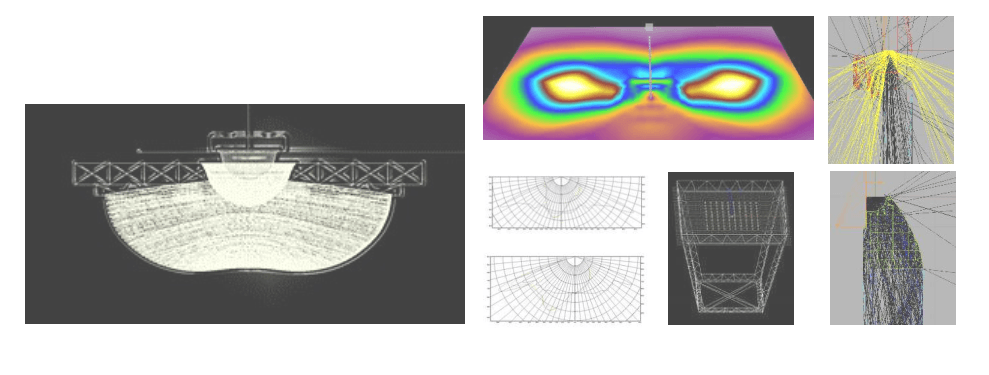Optical design and light simulations
Optical Design
We design customized optical components: lenses and reflectors for luminaires or light signaling devices.
The software used in candelTEC for design and simulation is
Photopia. It is a program specially designed for optical lighting applications. It performs photometric and radiometric simulations, and also allows modelling and optimization of optical components for lighting systems. The calculation is made by ray tracing, using geometries and distributions of real light sources.
We have validated the results obtained with this software by laboratory tests at our facilities.
Photopia allows the visualization of the processes of design and simulation, facilitating photometric análisis, design and optimization.
Photometric simulation of reflectors and lenses for lighting systems.
The simulation process requires the analysis of the path of rays that come from the light source and propagate, reflect, refract or scatter in different media. The final result of the ray tracing process provides the virtual characterization of the product, equivalent to the physical photometric test of the luminaire.
To carry out the simulation, the different elements (sources, optical elements, other components) with their real characteristics (measured in the laboratory or previously characterized by the client or their supplier) are introduced. In addition, Photopia has an extensive library with characterized light sources and materials from different suppliers.
Photometric simulations can reduce the design period of a product while providing valuable information on the performances expected of the luminaire to be developed.
Colorimetric simulations
The colorimetric simulation process is complementary to the photometric simulation. For colorimetric simulation, the light source (the LEDs, for instance) should be
characterized not only photometrically, but also spectrally.
We must consider that some products incorporating LED technology, present a significant chromatic angular deviation, being very important to have information on the variability of this parameter for the selected LEDs.
As results of this simulation process we can obtain global information on the colorimetric parameters of the product (such as color temperature or color coordinates). It is also possible to evaluate the angular variation of these parameters, or the spatial distribution and homogeneity of the colorimetric characteristics of the light reaching certain surfaces.
Special applications: luminaires for industrial and horticultural applications
It is obvious that light sources are not only used to provide visible light in certain domestic or public environments. There is a high number of applications in which certain levels of radiation are required to ensure that some industrial processes are carried out correctly, for example: curing, sterilization or guiding processes, among others.
In addition, in horticulture, radiation sources with specific action spectra are necessary, suitable for the different species that are cultivated, adequate to produce certain specific effects in the plants.
In all these cases, photometric and radiometric simulation allows the analysis of different sources and their combinations to obtain a specific spectral power distribution as a result, constructing and evaluating virtually the product, as a previous step to its construction. The simulation results provide us with very valuable information to develop a complete prototype, design or select its components and set up the arrangement of the different elements to obtain the desired product.






